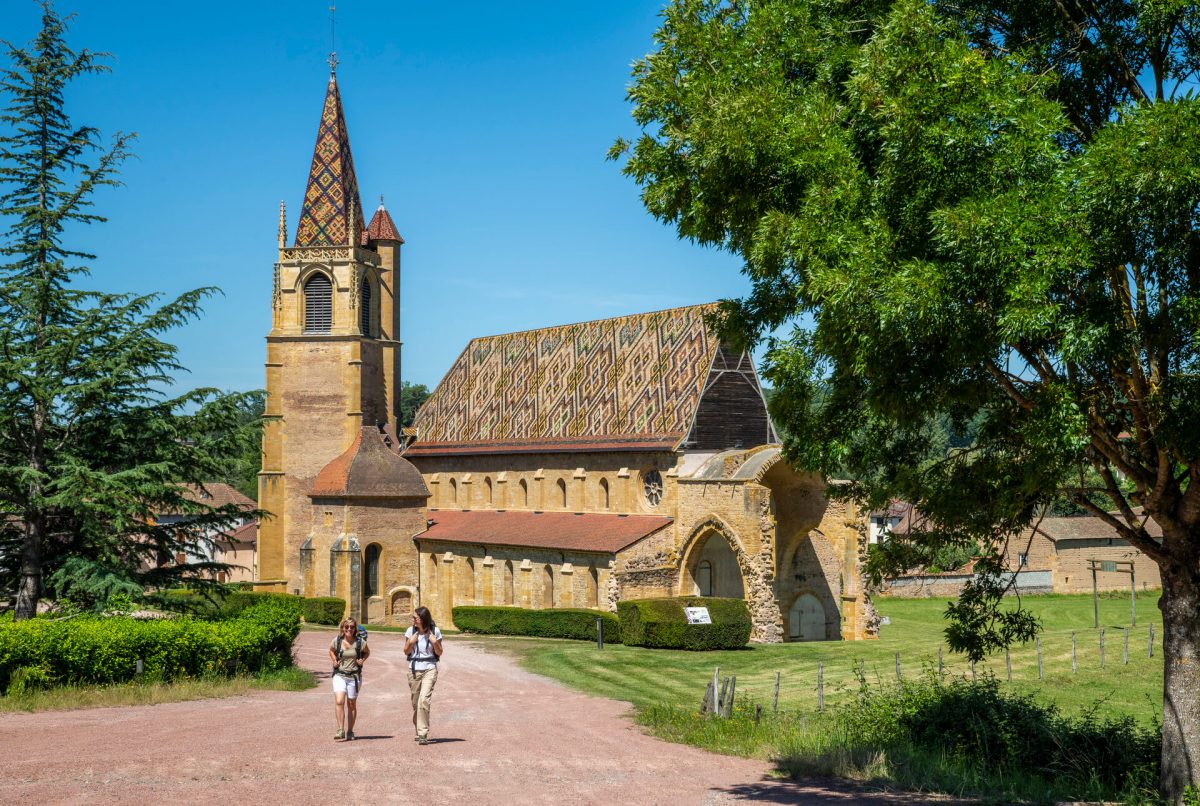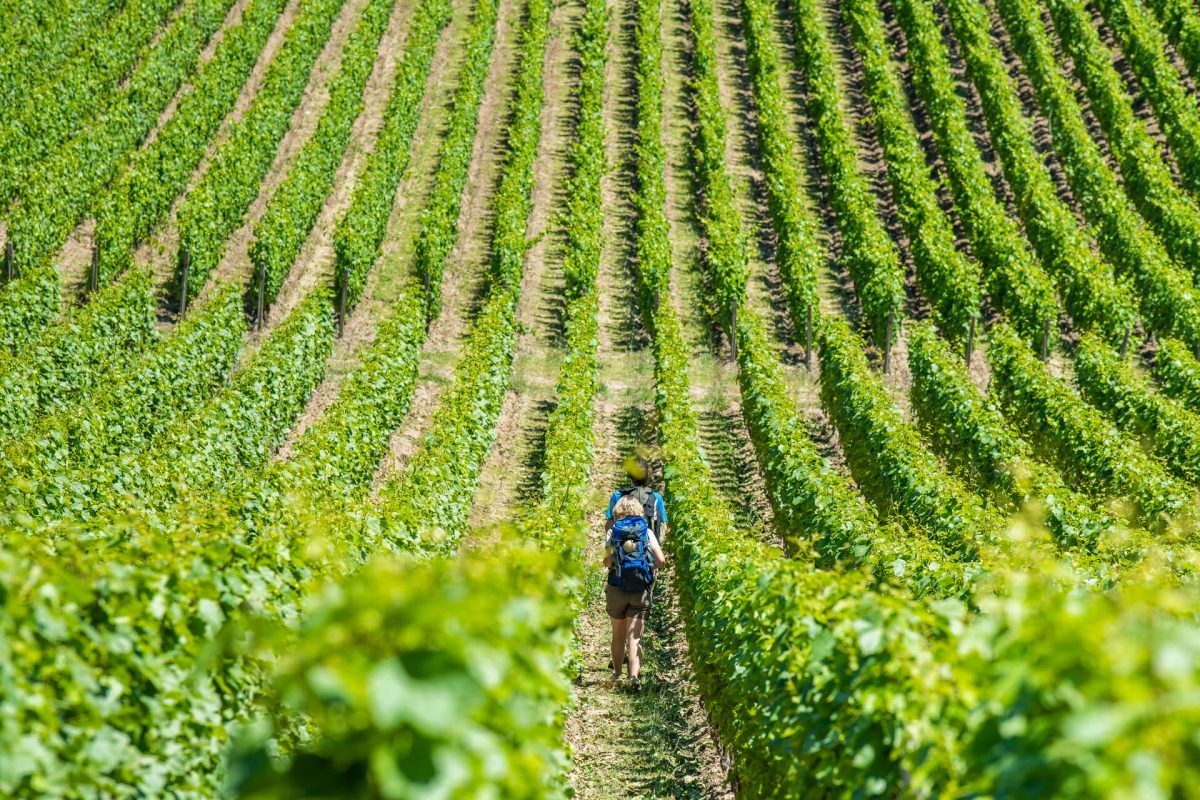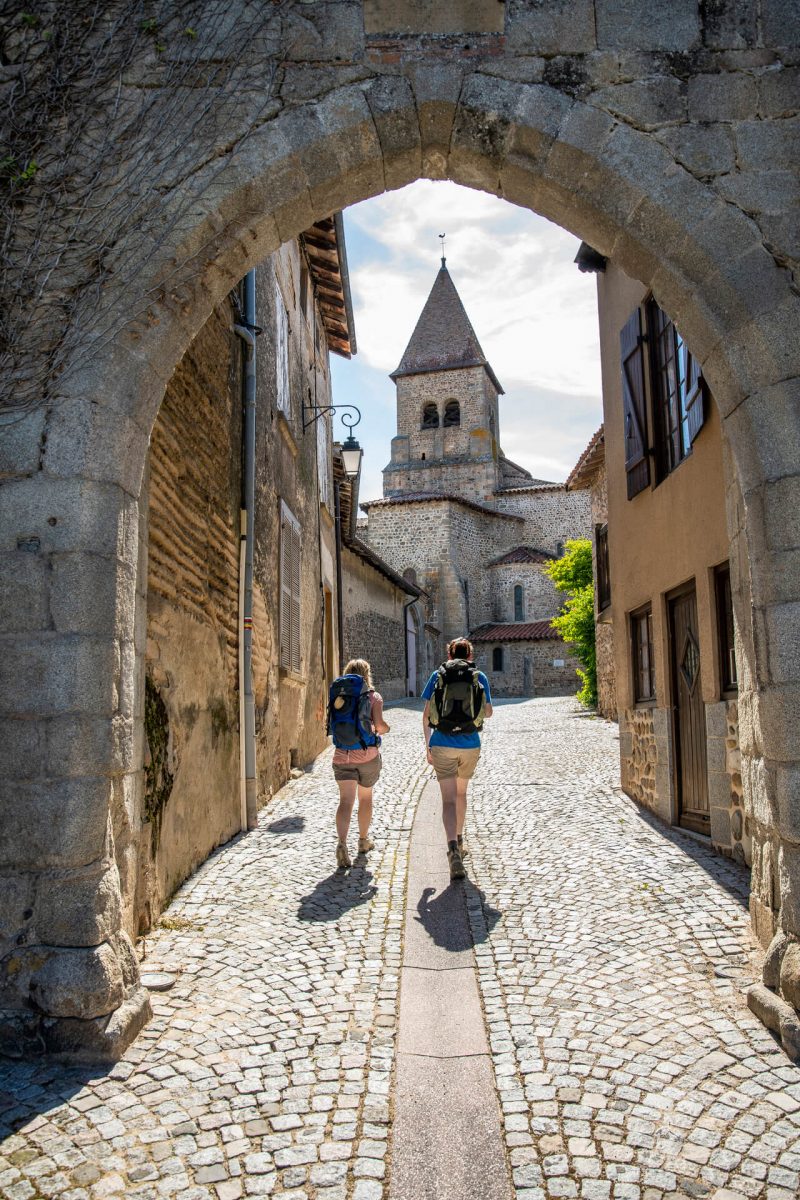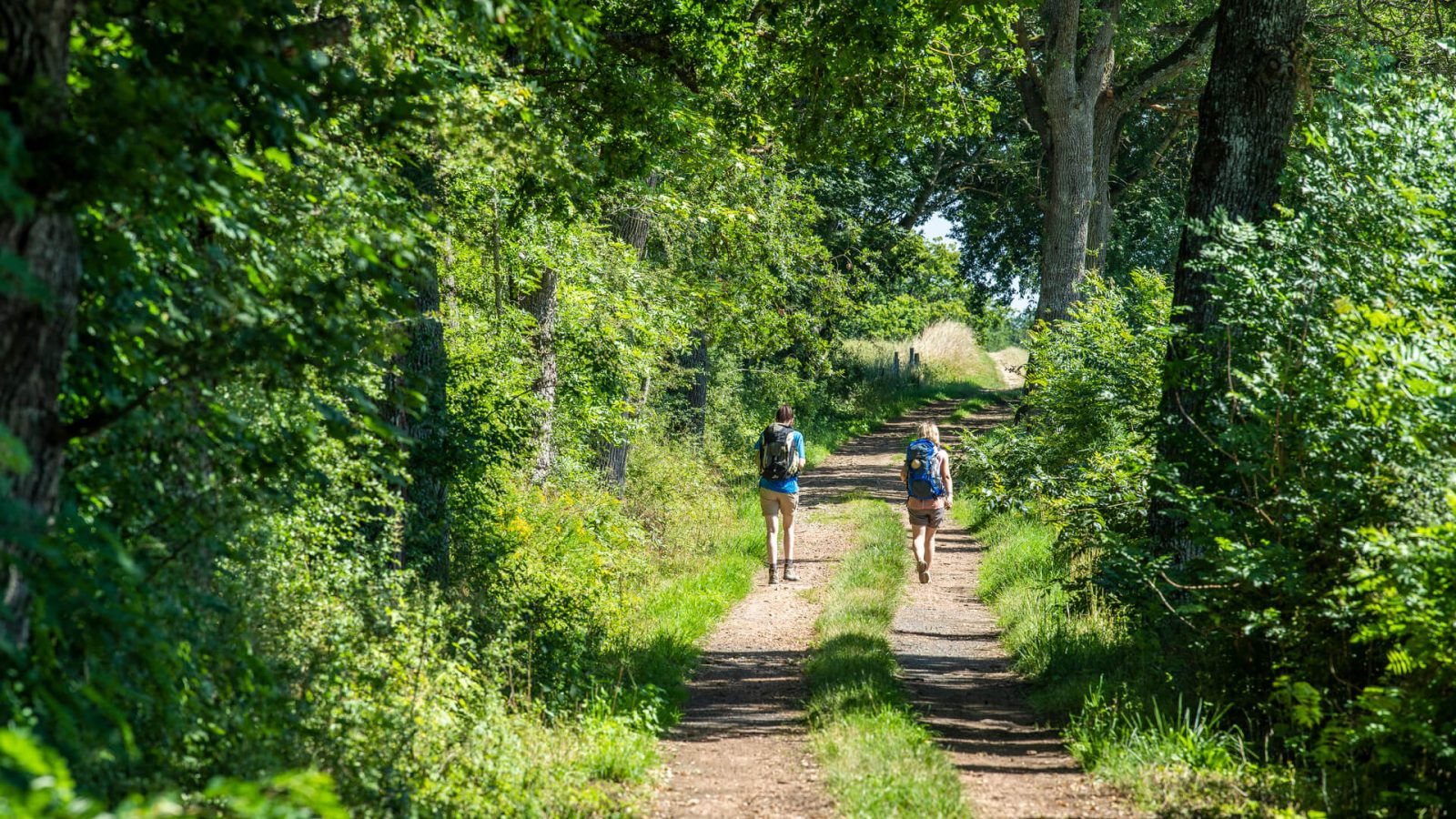In the Roannais, hiking can also turn into a spiritual journey as on the road to Saint-Jacques-de-Compostelle. This crosses the territory from north to south by the secondary route Cluny / Le Puy-en-Velay. Indeed, the GR 765 N connects Cluny in Saône-et-Loire to Puy-en-Velay in Haute-Loire, the most famous of the starting points towards Compostela. Reference route for hikers as for pilgrims, the road to Saint-Jacques-de-Compostelle has 4 stages on the Roannais, from the town of Cergne to Pommiers-en-Forez, over a distance of 90 kilometers.
Your itinerary in the Roannais
The dense forests of the Col des Echarmeaux give way to the rich heritage of the Pays de Charlieu. Second, the charming villages of character Saint-Haon-le-Chatel et Saint-Jean-Saint-Maurice-sur-Loire one after the other. The vineyard, the gorges of the Loire and the richness of the small built heritage which marks out this route make it a perfect concentrate of hiking and discovery in Roannais.

Stage 1: Le Cergne / Briennon
25 kilometers : Le Cergne - Arcinges - Charlieu - Saint-Nizier-sous-Charlieu - Pouilly-sous-Charlieu - Briennon
> 396 m of elevation gain
The trail crosses charming villages and winds through a forest on the banks of the Chandonnet river. After a gradual rise, the Sornin river emerges with the beautiful city of Charlieu as a backdrop. After crossing the Loire, the day ends in Briennon, a stone's throw from the Roanne canal in Digoin.
© Luc Olivier

Stage 2: Briennon / Saint-Haon-le-Châtel
25 kilometers : Briennon - La Bénisson-Dieu - Noailly - Saint-Romain-la-Motte - Saint-Haon-le-Châtel
> 392 m of elevation gain
The start of the route runs along the canal before plunging into the Bois Clair. After La Bénisson-Dieu and the discovery of its abbey, the streams follow one another bringing a pleasant feeling of freshness: the Teyssonne, the Cacherat, the Fillerin… The last part of the path crosses the fields which surround Saint-Haon-le-Châtel. A very nice stopover to spend the night with a medieval atmosphere and a breathtaking view of the Magdalen Mountains.
© Luc Olivier

Stage 3: Saint-Haon-le-Châtel / Saint-Jean-Saint-Maurice-sur-Loire
20,5 kilometers : Saint-Haon-le-Châtel - Renaison - Saint-André-d'Apchon - Saint-Alban-les-Eaux - Lentigny - Saint-Jean-Saint-Maurice
> 424 m of elevation gain
The first stop is at Renaison, in the heart of the Côte Roannaise vineyard. In Saint-André-d'Apchon, the castle invites you to dream before reaching the woods. You will finally arrive in Saint-Jean-Saint-Maurice-sur-Loire, with its character inherited from the Middle Ages.
© Luc Olivier

Stage 4: Saint-Jean-Saint-Maurice-sur-Loire / Pommiers-en-Forez
20 kilometers : Saint-Jean-Saint-Maurice-sur-Loire - Vézelin-sur-Loire - Pommiers-en-Forez
> 314 m of elevation gain
Bully and Vézelin-sur-Loire follow one another, interspersed with majestic forests, like that of Bas. We pass not far from the gorges before reaching today's destination: Pommiers-en-Forez. The village alone is worth the trip. Very old city, the monks invest the priory until the Revolution. A real part of history that will fascinate you.
In conclusion, this path continues beyond Roannais to reach Le Puy-en-Velay, Conques, Aumont Aubrac to Santiago de Compostela and therefore complete the pilgrimage in its entirety.
© Luc Olivier
A journalist recounts her journey on the road, from Charlieu to Pommiers-en-Forez
![sur les hauteurs de Noailly, sur le chemin de Saint Jacques de Compostelle dans la Loire]()
© Cerise Rochet / Progress ![Commune de Amions sur le chemin de Saint Jacques de Compostelle dans la Loire]()
© Cerise Rochet / Progress ![sur les hauteurs de Noailly, sur le chemin de Saint Jacques de Compostelle dans la Loire]()
© Cerise Rochet / Progress
In 2020, a journalist from Progress, Cerise Rochet, sets out to hike from Charlieu to Pommiers-en-Forez in the footsteps of Saint-Jacques-de-Compostelle. She observes changing landscapes and takes advantage of historic sites to take breaks. With an average of 20 kilometers per day, it progresses in just 4 days to the Priory of Pommiers and promises to set off again in 2021 to reach Le Puy-en-Velay. She recounts her journey through 4 articles on the newspaper Le Progrès:
- Step 1: Charlieu / Noailly : from the Cluniac sites to the Roannais valleys
- Step 2: Noailly / Saint-Haon-le-Châtel : through the great outdoors
- Step 3: Saint-Haon-le-Châtel / Saint-Jean-Saint-Maurice-sur-Loire : the vineyard route
- Step 4: Saint-Jean-Saint-Maurice-sur-Loire / Pommiers-en-Forez : between Roannais and Forez
Churches, vineyards and banks of the Loire
Churches, chapels and other religious sites outline the route. The hiker goes from discovery to discovery: Abbey of Charlieu, Abbey of La Bénisson-Dieu and its glazed tile roof.
Vines and forests also mark this route. At the edge of mounts of the Madeleine, the green Beaujolais and the Livradois-Forez park, the beech groves, fir trees and pastures are never very far away even if along the slopes, they give way to the vineyards. Coteaux du Lyonnais, Beaujolais, Côte Roannaise and Côtes du Forez are there to testify.
The route approaches the Loire after the town of Lentigny and borders on Lake Villerest. The hiking trail then runs along and overhangs the Loire to the village of Vézelin-sur-Loire.

What is the real story of the road to Santiago de Compostela?
The aim of the Catholic pilgrimage to Santiago de Compostela is to reach the tomb of the apostle Saint James the Greater, located in the crypt of the Cathedral of Santiago de Compostela in Galicia (Spain ).
Legend has it that after the execution of St. James in Jerusalem. Two of his disciples place his body in a stone boat, without sail or rudder, and set out to sea. The boat, pushed by the wind, the waters and a divine hand, ran aground on the Galician coasts. A king and a queen refuse to grant them land to bury Jacques and seek to kill them. The holy men triumph over all their perils, the king dies and the queen is converted. The body is buried in a safe place and forgotten.
At the IXe century, a hermit receives the revelation of the place of the tomb. Following excavations, the city of Santiago de Compostela emerges from the ground.
A legend which is invalidated by several other stories of the body of Saint-Jacques. In France, we have three tombs, nine heads and many members!
In 1940, Jean de Tournai, famous for his account of his various pilgrimages, listened to each legend and concluded by affirming "anyway, Saint-Jacques is in Paradise".
Jean of Tournai
Ldates Keywords
- It is only in 1942 that Pope Alexander VI officially declares Santiago de Compostela the place of one of the three great pilgrimages with those of Jerusalem as well as Rome.
- En 1987, the ways of Compostela were declared “First cultural itinerary” by the Council of Europe.
- From 2013, more than 200 pilgrims tread the paths, each year, with a growth of 000% per year.
The topographical guide
Despite perfect signage along the route, a guidebook can be useful for reassurance and for providing historical and practical information. The topographical guide "Path to Saint-Jacques-de-Compostelle" contains details of the hiking trails. You will find it for sale online and in the Tourist Offices of the Territory (Roanne and Charlieu).
In this book you will find:
- The detailed map of the route,
- The technical description of the steps,
- The list of services available to you along the route (restaurants, accommodation, shops, etc.),
- Articles on heritage to discover along the route.
Luggage porterage
The FFRandonnée Auvergne-Rhône-Alpes and the CAPEV (Community of Agglomeration of Puy-en-Velay) are committed to providing new quality services to itinerant hikers, including luggage portage.
This service is effective on the GR® 765 Cluny / Le Puy-en-Velay with the company the mailbox. It facilitates the logistics of hikers and pilgrims

Marion's opinion
I only walked the paths of Roannais which lead to Compostela during a photo shoot. But I know the feeling of walking on this pilgrimage path which brings us back to basics and which makes us all equal. From Puy-en-Velay to Cahors, in 2005, I walked on “el camino”… my dream, to leave with my backpack to make the entire pilgrimage.









